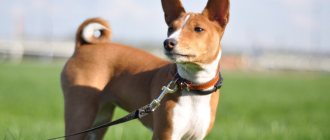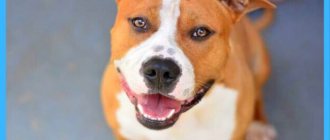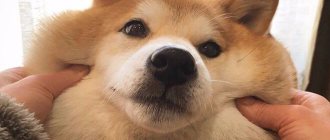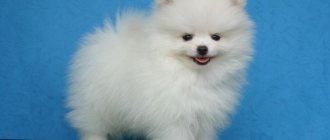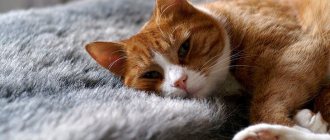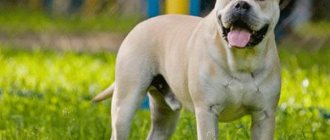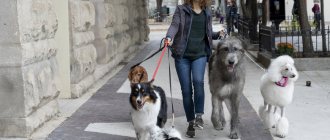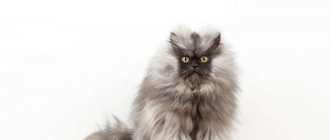| Breed name: | Shiba Inu |
| Breed name in English: | Shiba inu |
| Country of origin: | Japan |
| Type: | A small dog |
| Weight: | 7-13 kilograms |
| Height (height at withers): | 35-42 centimeter |
| Color | Black and tan, red sesame, cream, black sesame, sesame, red |
| Wool length | Short |
| Lifespan: | 12-15 years |
| Character | Charming, funny, fearless, loyal, smart, sweet |
| Number of puppies (average): | 2-3 |
| Price of puppies: | 500-3500$ |
Description
The Shiba Inu is a hunting dog bred in Japan. Dogs are considered a national treasure and symbol of this country. An animal's smile wins many hearts. The Shiba Inu is a dog with a lively personality and playful nature. This is an active animal that loves to travel, walk and run with its owner. Pets are independent and brave, making them difficult to train. The dogs are also very clean and spend a lot of time grooming themselves.
Who is better to choose
The strong similarity of the two breeds often gives rise to the question of who is better to have, an Akita or a Shiba. When choosing, you need to focus on many factors: place of residence, free time, physical activity, training experience, presence of animals and children.
Akita Inu will be an ideal choice for people:
- living in a private house;
- having no animals or children;
- able to devote a lot of time to the pet;
- looking for a dog to be a guardian and a hunting assistant.
In turn, the Shiba Inu is perfect for those who:
- lives in an apartment;
- physically active (this will be needed during walks);
- able to show patience in training or already has experience;
- contains other animals;
- raises children.
Expert opinion
Anna Abramenko
An avid dog lover. Experience in veterinary medicine since 2009.
Ask a Question
This comparison is conditional. Both breeds are active, friendly, and strongly attached to their owner. A dog's behavior depends, first of all, on the quality of its upbringing. Even the most restless puppy can be turned into an intelligent and patient animal with the help of training.
Future owners should approach the choice of a puppy responsibly. Under no circumstances should it be presented as a gift. Each person must make his own decision about the degree of responsibility he is willing to assume.
Appearance
— Advertising —
The standard specifies the following breed parameters.
Head
The head is triangular in shape. The size of the skull is moderate and proportional to the body. The forehead is wide and flat, with a slight furrow. The lower jaw protrudes slightly forward. The length of the muzzle makes up 40 percent of the total length of the head. Scissor bite. The mouth contains strong, white, even teeth.
— Advertising —
The eyes are deep-set and inclined towards the outer base of the ear. The iris is dark. Eye color – brown, black edging. There are other eye colors - black, gray, light yellow and light blue. However, they are not recognized as a standard.
The ears are triangular in shape, set far apart and tilted straight forward. Nose is black.
Neck, back line and body
The neck is strong and of medium length. The back line is straight, level with the base of the tail. The body is dry and muscular. The lower back is strong. The tail is thick and powerful, set high. It is located at the level of the back in a crescent or ring-shaped position.
Limbs
The elbows are located close to the body. The front legs and feet are straight and parallel. The paws are “cat-like”, with well-arched toes that fit tightly together. The hind legs are strong. Strong hock joint.
The Japanese Shiba Inu dog has a double fluffy coat. The outer coat is hard, smooth and straight, the undercoat is soft and thick. The coat color and pattern can be of the following varieties:
- Black with red splashes.
- Sesame (sesame) red.
- Cream.
- Sesame black.
- Sesame.
- Ginger.
- Brindle.
- Albino.
Varieties
Such a dwarf dog has a height at the withers of 19-30 cm. But the size of the pet does not fit the standard. There is no official recognition or registration of the breed. The distinguishing feature is the color of the coat. The main colors that are accepted by the breed standards:
- Red is considered the most common. Rich, without a tint of orange. The undercoat of dogs is white or ash-gray. This color includes red fur with small patches of black fragments.
- Black and tan, in the bright sun the hair shimmers with all the colors of the rainbow. The undercoat of such individuals is white or ash-gray.
- Black and red sesame. The base is red, with uniform patches of resin color along the body.
White dogs look presentable, but according to standards they are subject to rejection.
Experienced breeders believe that the final color of a dog’s coat is established by the age of 3-5 years.
Pros and cons of a dog
You may fall in love with this smiling dog from the first minute. But before you make such a friend, carefully study his positive and negative sides.
Characteristics of advantages:
- These are energetic and active individuals.
- Dogs have high intelligence, so they are easy to train.
- Pets are easy to care for.
- Dogs have almost no salivation.
- They are not prone to sudden weight gain.
- The dog has excellent security qualities: he always protects his owner.
- They are suitable for first-time owners.
- This is a relatively healthy breed.
- Pets are not allergic.
Characteristics of minuses:
- The animal is very stubborn and independent.
- The dog has a high degree of shedding.
- They may run away from home.
- Pets do not get along well with cats and other dogs.
- An animal will feel better in a house than in an apartment.
- If an individual is not socialized from an early age, then it will be overly suspicious of strangers.
Which breed is best suited for indoors and outdoors?
Akita Inu has large dimensions, so it is most logical to get one when living in a private house. At the same time, these dogs do not need long-term active exercise (to maintain calmness and obedience), so they can be kept in apartments.
Although the Shiba is smaller in size, it still needs regular and long-term physical exercise on the street, so it is advisable to get a dog when living in a private house with a spacious yard. However, you can live with an animal in an apartment if you go outside regularly.
Pets on a walkIf you ignore walks, dogs can become disobedient and very active. In this case, they begin to chew household items, furniture, and wires. If the Shiba Inu lives in a private house, then you need to take into account that these individuals do not like chains, collars, or leashes. Dogs may become more aggressive and unruly when using these items.
You can keep dogs in an enclosure or just in the yard, but provided that the owners pay due attention to training the pet
Important! If you get an Akita to live in an apartment, then you should give the pet a separate corner, equipped with sleeping places and toys.
Important! If you get an Akita to live in an apartment, then you should give the pet a separate corner, equipped with sleeping places and toys. With proper comfort, the dog will spend most of its time in its corner
If you plan to keep it in an enclosure, it will need to be insulated and equipped with a sleeping place.
With proper comfort, the dog will spend most of its time in its corner. If you plan to keep it in an enclosure, it will need to be insulated and equipped with a sleeping place.
History of the origin of the breed
The description of the breed says that the Shiba Inu is not only the smallest of the Japanese Spitz, but also the oldest. For example, excavations have shown that this breed lived in the Land of the Rising Sun around 7000 BC.
It is controversial whether the breed arrived in Japan from North Asia or Korea. But most experts agree that the Shiba Inu descended from dogs that arrived in Japan during the first or second major human migration. This means that the breed has been present in the country for between 2,300 and 10,000 years. According to National Geographic, Shibs are genetically similar to wolves. This indicates that it is one of the oldest domesticated breeds.
External influences had no effect on Japan for centuries. This is due to the fact that the country was closed, so the dogs were not crossed. That all changed in 1854 when American naval officer Admiral Perry arrived with warships and forced Japan to reenter the world community. Foreigners exported other breeds to Japan and mating of different individuals began. The original Shiba Inu began to disappear.
Rural areas still maintained the integrity of the species as they had less access to foreign dogs.
Inu is definitely a Japanese word. But where the word "shiba" came from is still debated. Shiba is the Japanese name for brushwood. This is a certain vegetation that was common in areas where dogs hunted.
It has also been suggested that "shiba" could mean "small" in an older dialect. Therefore, the breed was named after its size. Whatever its origins, the name "Shiba Inu" was officially coined in Japan in the 1920s.
In 1928, Dr. Hiroyo Saito founded the Nihon Ken Hozonkai (Association for the Preservation of the Japanese Dog). In 1936, the association managed to achieve the declaration of the species as a Japanese national monument.
Unfortunately, many individuals died during World War II as a result of bombing. After the war, breeding programs were reinstated. They used Shiba Inus that survived in remote rural areas.
It is known that the first Shiba Inu was brought to the United States in 1954. He arrived with a military family who were returning from Japan.
The pet's first known American litter was produced in 1979. Many people believe that this year the animal established itself in America. However, it was not until 1992 that the breed received full recognition by the American Kennel Club.
How to care for a “teddy” pet
The American Akita is a fairly large dog that will feel more comfortable in a spacious house than in a small city apartment. But despite this, she easily adapts to any conditions. A silent dog will not bother neighbors with its loud barking or whining when its owners are away. And this is another plus for people who are periodically absent from home.
The pet does not require any specific care. But in order for the American Akita to always look neat, you need to adhere to some simple rules:
- bathing - as they become dirty, show dogs are washed before each show; it is worth noting that the coat of American Akitas is capable of self-cleaning;
- nail trimming - as needed;
- cleaning ears and teeth - once every seven days;
- combing the wool - twice a week, during shedding, which happens twice a year - every day.
Training and education of the American Akita
It is necessary to start socializing your pet as soon as he opens his eyes and begins to hear, that is, from two weeks of age. From this moment on, you should accustom the puppy to the voices of people, including loud radios and TVs, to the sounds of the surrounding world: to the buzzing of lawn mowers, to cars. The sooner you start working with your pet, the more successful it will be. Since this breed has Shepherd blood flowing through it, they are easy to train.
It is very important at the very beginning of the education and training process to show the puppy who is really the boss. If this moment is missed, the pet will not obey and follow commands.
The American Akita does not like playing with various kinds of toys; most representatives of this breed are extremely indifferent to treats, which means that the best means of motivation are words of praise, a smile and a good-natured look from the owner.
Show dogs are taught show tricks
Walking with an Akita
To make your pet feel comfortable, he needs hour-long walks twice a day. Akita does not need intense physical exercise, but at the same time it is a fairly hardy dog. She can run 7–10 km behind a bicycle.
It is almost impossible to suppress the hunting habits of a pet. So, during a walk, an Akita can rush at representatives of smaller breeds of dogs, birds and cats. But she is loyal to representatives of her breed. Akita can attack cats and other animals living in the same apartment.
The pet tolerates any weather conditions well. So, in winter he can happily roll around in the snow; in summer, when it’s hot, he can find himself a comfortable place to rest.
The American Akita easily tolerates any weather conditions
What to feed an American Akita
The American Akita is not picky about food. She can happily eat both ready-made store-bought food and homemade food. But it is worth remembering that your pet cannot be fed from a common table. A dog's diet is significantly different from the diet of humans.
The American Akita's diet should be rich in vitamins and nutrients. This especially needs to be taken into account when feeding homemade food. When choosing ready-made food, preference should be given to premium or super-premium products.
The list of prohibited and permitted foods for Akitas is no different from what is suitable for other dogs.
Pet health
Despite the fact that the American Akita has strong immunity and is known for its endurance, the list of diseases to which this breed is predisposed is quite extensive:
- Hip dysplasia. It occurs as a result of increased load on the musculoskeletal system as the pet grows up. If the problem is not detected promptly and treatment is not started, it can cause disability for the pet.
- Volvulus. It occurs as a result of the individual structure of the pet’s digestive system. The problem can be solved surgically if you consult a veterinarian in a timely manner.
- Cushing's syndrome is a disease of the endocrine system, which consists of excessive production of the hormone cortisol, which leads to gastrointestinal disorders, hypertension and a number of other complications. The disease most often occurs in older dogs. Therapy is taking expensive medications.
- Food allergies. It can be difficult to recognize the disease in the early stages due to the thick coat. It is necessary to carefully choose natural food products and buy food designed specifically for animals with allergies. The disease should be treated by a veterinarian. Some pets are allergic to their own fur, which manifests itself during the molting period.
Joint dysplasia manifests itself throughout life in the form of lameness and abnormal gait.
Maintenance and care
There are some things you need to know:
- Shiba is incredibly energetic and muscular. Therefore, pets need physical activity and walks. When walking, you will need a secure harness that will not choke your dog. It should be made of durable material, with a neck circumference of 22-27 cm. Avoid dangerous retractable leashes.
- Sibs are smart dogs. You should stimulate their mental abilities periodically. Keep them busy for long periods of time or give the dogs a goal.
- Chewing is a great way for your high-energy Shih to burn off energy. Give her tasty treats that take a long time to chew.
- The pet will play a lot, so it needs its own place to rest. The place where he sleeps should be secluded and comfortable. Periodically change and wash your dog's blanket or cape.
- Sometimes pets are too active. To protect your home from destruction, purchase or make a playpen.
- Feed your dogs high-quality, varied, balanced food.
- Brush your friend periodically. Healthy wool is light, airy, and has a natural shine. Don't cut your pet's hair. Only trimming the mustache and pads of the feet is allowed.
- Bathe your pet as needed. Usually once every 3 or 4 months is sufficient. Choose a special shampoo or natural soap. They should smell nice, not irritate the skin and not cause shedding.
- Check your pet's claws about once every two months. If they don't fade naturally, cut them at home. Use a special nail clipper. If you are afraid to do this, then contact your veterinarian's office.
- In winter, buy your baby a pair of overalls for walking.
Reproduction and lifespan
The issue of breeding must be decided as soon as the decision is made to adopt a puppy. If you are not going to breed an animal, you need to take timely measures to avoid offspring. And if you decide to start breeding, here’s some immediate advice: don’t take the process as a chance to earn extra income.
Shiba Inu puppies are of course expensive, but a lot will be spent. In addition to attention to the pet itself, you will also need assistance during childbirth, and then raising and feeding the puppies. There are usually not many of them in a litter - 3-4, but sometimes there are up to 8. Then it becomes very difficult. Besides, the more kids there are, the less strength they have.
And then it’s more difficult to place puppies. Therefore, many, having decided to knit once, do not take this step again. It usually occurs for the first time after the 3rd heat, at the age of 15 months. Pregnancy lasts about 9 weeks. Before giving birth, prepare a first aid kit and call your veterinarian.
The animal is not prone to special genetic diseases. In addition to problems with the eyes, there may be some difficulties with the bones - a shortened spine, osteochondritis. They live for about 15 years, and sometimes 20 years.
Nutrition
Owners know that the breed is very independent and prone to bouts of “activity.” Dogs that do not receive adequate nutrition may become lethargic and anxious due to lack of nutrients. The right food supports their brain and motor functions.
What to feed your Shiba Inu?
Be careful about how much and what you feed your Great Dane.
The main necessary substances for the breed:
- Protein. It contains amino acids that are essential for creating healthy muscles, tissues and cells. Protein, found in proteins, helps with development during puppyhood and adulthood. The ideal source of protein for the species is whole animal meat.
- Fiber is needed for two main purposes. It helps produce the energy needed to stay active and also promotes a healthy digestive system.
- Carbohydrates. They are a source of quick energy. Large amounts of carbohydrates can be harmful to your pet. High-quality dog food formulas already take care of the ratio of protein to fat and carbohydrates. Therefore, you just need to make sure that you follow the feeding instructions.
- Omega 3 and 6 fatty acids and vitamins. They are important components that contribute to the health of your pet's skin and coat. The coat will shine when the dog gets enough Omega 3 and 6.
- Fat. It is needed to process nutrients and produce hormones. Contrary to popular belief, fat does not cause weight gain. Rather, it helps provide sustained energy so your pup can enjoy walks and play without becoming prematurely tired. If you notice that your friend is showing signs of lethargy, he may not be getting enough fat or other nutrients in his diet. Discuss these symptoms with your veterinarian.
How much to feed your Shiba Inu?
All dogs have approximately the same nutritional needs. However, there are differences in energy needs depending on the age, gender and activity level of your pet.
The easiest way to determine how much to feed your pet is to follow the recommendations on the food package. The problem is that these recommendations may not take into account your pet's activity level. If you want to be more precise, you can calculate his actual calorie needs.
The average energy requirement for an adult is about 30 calories per 0.45 kilogram.
Keep in mind that small pets have a very fast metabolism, while larger pets have a slower one. The Inu falls into the first of these categories, having a maximum weight of about 11 kilograms. Animals this size typically require more calories because their daily energy expenditure is higher. Therefore, they need 35 or 40 calories per 0.45 kilograms. This gives a range of 595 to 1000 calories per day, depending on the size of the individual.
Usually the animal eats well. But if your dog refuses to eat for a day or more, contact your veterinarian immediately.
Dog handler's opinion
Expert opinion
Kozhevin Semyon Kirillovich
Expert dog handler.
“The Shiba Inu is a representative, albeit similar to the Akita, but still a different breed. These are medium-sized dogs, mostly bright red in color, distinguished by a bold, but at the same time balanced and calm disposition, intelligent and friendly towards their owners. They are better suited for living in an apartment than their larger “relatives,” but you need to remember that these dogs need significant physical activity.
It’s not difficult to keep a mini Akita, but you need to take into account that these dogs need a special diet, since during the long isolation in their historical homeland, the Shiba Inu has developed special taste preferences.”
Girl
Girls weigh 7-10 kilograms, they grow to 35-39 centimeters.
In appearance, females are slightly smaller than males.
The girl is more aloof, especially with strangers. This trait is due to the fact that the female is more cautious.
Neutering also affects her behavior. Spayed females show aggression less intensely.
However, the female Shiba Inu is quite intelligent. Therefore, it is easy to train.
brief information
Useful brief information about the main parameters of a dog of the Shiba Inu breed, or Shiba Inu in other words, the ICF classification and information about its closest relatives (breeds) are presented in the table
| ICF classification | 5. Spitz and primitive breeds |
| 5. Asian Spitz and related breeds | |
| Number - 257 | |
| Country of origin | Japan, origins 3rd century BC. era |
| Weight | 7-14 kg |
| Height | 35 – 42cm (males 41cm, females 37cm) |
| Wool | Dense, thick, short |
| Color | White, red, black, dark gray |
| Immediate family | Shar Pei, Chow Chow, Akita Inu |
| Life cycle | 13 – 18 years old |
Boy
The weight of males reaches 10–13 kg, height – 38–42 centimeters.
Males are usually larger in height and weight. Males should have wider muzzles. Females are generally smaller.
A properly raised male is more friendly and interested in making new acquaintances than a female. On the other hand, a poorly behaved boy may be angry and want to dominate.
There is also a difference between intact and castrated males. Intact individuals more often have a predisposition and desire to dominate compared to castrated ones.
Due to the hormone testosterone, boys may be more active than girls.
Most experienced owners recommend taking males for the first time. They are usually more sociable, affectionate, and easier to handle.
Features of character and intelligence
The Shiba Inu has characteristics close to freedom-loving hunting dogs. Representatives of the breed are distinguished by their independence, stubbornness, high playfulness, they have retained a strong hunting instinct and at the same time are devoted to their owner.
The breed is freedom-loving, which makes it difficult to teach it to walk on a leash and with a collar. The natural cleanliness of the breed allows them to quickly adapt to the walking regime. Even when the dog is kept in an enclosure, it strives to maintain as much cleanliness as possible and will tolerate it until it is taken out for a walk.
Dogs don't tend to bark for no reason. They speak up when there is a reason for it. If the dog is not happy, he screams. The dog’s pronounced stubbornness along with a fairly high intelligence becomes the reason that it quite often begins to manipulate its owner and does only what it wants, and only if it is encouraged for it. Like all other breeds, the Shiba Inu has a description that combines very attractive qualities and those that limit the possibility of keeping such a pet by an inexperienced owner.
Security guard potential
It is not recommended to have this dog as a guard dog. She will give a voice when a stranger approaches, but will not be able to protect the owner or his property if necessary.
Attitude towards people
Dogs are loyal to their owners, but without excessive display of emotions. Shiba Inus are wary of strangers, will not come close and will try to constantly monitor their location with their eyes. The dog's toy appearance does not at all correspond to its behavior. She will not be a companion who is always ready to communicate and constantly waits for the owner to pay attention to him. If a stranger tries to touch the dog, it will most likely show aggression.
Physical data
These dogs are medium in size. The weight of a male is from 10 to 13 kilograms, and that of a female is from 7 to 9 kg. The height of the animal also varies depending on the gender. The height at the withers for males is from 39 to 41 cm. The height of the female is from 35 to 37 cm at the withers. If an animal exceeds the height and weight standards established by the standard, it is considered a defect, which entails culling.
Appearance
Externally, the animal looks very attractive and resembles a husky and, to some extent, a smooth Spitz. The Shiba Inu comes in a variety of colors: red, wolf, white and black and tan. Having a strong physique, the animal looks fit and graceful. The special expression of the muzzle makes the dog look like a toy.
Nicknames
For boy
Popular Japanese boy names with meaning:
- Akira - bright.
- Daiki - great glory, nobility.
- Haruki is the shining sun.
- Hinata is a sunflower, facing the sun.
- Hiro is generous.
- Ichiro is the first son.
- Itsuki - forest trees.
- Jiro is the second son.
- Kichiro is a happy son.
- Kiyoshi – purity.
- Kuta is a great world.
- Masaki is a big tree.
- Masato is a righteous man.
- Masumi – true clarity.
- Nao - honestly.
- Nori - edit.
- Osamu – disciplined, diligent.
- Riku is earth.
- Shinobu – endurance.
- Takahiro – valuable, noble.
- Takashi is prosperous.
- Toshi is wise.
- Yasushi – peaceful.
For girl
Popular Japanese nicknames for girls with meaning:
- Akemi is a bright beauty.
- Asami - morning beauty.
- Haru - spring.
- Hideko is a child of perfection.
- Hikari – light, radiance.
- Hiro is generous.
- Hiroko is a generous child.
- Hoshi is a star.
- Kimi is noble.
- Kiyomi is pure beauty.
- May - dance.
- Maiko is a child of dance.
- Maki is true hope.
- Mika is a wonderful scent.
- Miku is a beautiful sky.
- Mio is a beautiful cherry color.
- Misaki is a beautiful flower.
- Natsuki is the summer hope.
- "Peekaboo" is a women's hairstyle.
- Rio - Sakura Village.
- Satoko is a wise child.
- Shinju is a gem.
- Shiori is a poem.
- Sora is the sky.
- Yoshi is a lucky guy.
- "Foxy" is a fox.
- Yuki is happiness.
Breeding
The first heat in girls begins at 5-6 months. However, a bitch can be bred from the age of 7-12 months.
Females come into heat once or twice a year. It lasts approximately 21-28 days. At this time, the bitch begins to have bloody discharge and an unpleasant odor. 10-15 days are the most suitable for mating.
Before mating, you need to prepare the future parents. Carry out deworming and vaccination a month in advance. Two weeks before the expected date of breeding, start feeding the expectant mother high-protein foods.
Pregnancy of individuals lasts 58-68 days. You need to prepare the birthing area in advance.
If your girl is giving birth for the first time, ensure that an experienced breeder or veterinarian is present at the birth. They will be able to help if the dog cannot cope on its own.
On the day of birth, the girl will lie down a lot, her basal temperature will drop to 37°C.
At one time, the bitch gives birth to 2-3 puppies. A newborn baby weighs 400-700 grams.
What to feed your Shiba Inu
An adult Shiba Inu dog is fed 2 times a day. Babies from two months of age should be fed 5 times a day, gradually reducing the number of feedings as they grow older. The diet should be balanced, consisting of 18-20% fats and 20-30% proteins. The diet should include sea fish, raw, frozen and scalded meat, and rice is best for porridges.
You cannot feed your pet:
- cabbage;
- sweets;
- legumes;
- citrus fruits;
- grapes;
- pickled, smoked products;
- spiced products;
- sausages, sausages, cheeses;
- fatty meats;
- rich pastries.
Note! When preparing your pet’s diet, do not forget about the tendency of this breed to be allergic to many foods. A new product should be introduced carefully, in small portions.
Puppies
What do you need to know before buying a new miniature friend? You need to understand what to feed your baby, as well as what items he may need.
Buy the following items:
- Toys.
- Feeder/water bowl.
- Baby wipes.
- Paper towels, rags.
- Cleaners.
- A crib.
Some tips for caring for babies:
- Feed your pet special food two or three times a day. Features depend on a number of factors, including how active your dog is and his age. The cub should always have clean water available.
- The pet's fur is odorless and does not need to be trimmed. But it sheds constantly, especially intensively twice a year (autumn and spring). Brush your pet once a week to remove dead hair. Start the procedure as soon as you pick up your new friend so that he gets used to the sensations.
- Bathe your dog only when necessary. If the pet has not rolled in the mud, then bathing it once every three or four months is enough. Use dog shampoo and rinse off any residue thoroughly with warm water.
- Take your pet outside. Toddlers love to run and play outdoors. Therefore, give him this opportunity as often as possible. Fence an area of your yard and regularly check for weak spots. Dogs can easily escape due to their small size. Walk your puppy regularly so that he gets used to the leash and obeys commands.
- Start obedience training early. Dogs need discipline. They are notoriously stubborn and sometimes difficult to train. Teach your pet proper behavior as soon as he comes home.
- Follow your vaccination schedule.
How to feed and how much food to give babies?
For four weeks after receiving your puppy, continue to give him the same food that the breeder gave him.
Dogs' digestive systems are different from ours and can be quite delicate. They don't crave variety and don't adapt to different foods the same way we do. Different foods contain different types of protein, amounts of fiber and fat. Drastic changes in diet can lead to stomach problems.
If you decide to change your food, it should be done gradually over a period of about one week. For the first two to three days, mix about three-quarters of the existing food with a quarter of the new food.
During the next stage, give him three-quarters of the new food mixed with a quarter of the old food. Do this for 2-3 days. At this stage, your puppy's digestive system should adapt to the new diet.
If any problems occur or your puppy is suffering from diarrhea or vomiting, consult your veterinarian.
Proper nutrition of the baby is vital for his health and further development.
According to the recommendations of the National Club of America, you should feed your puppy a high-quality, high-protein food. One that contains at least 30 percent protein and 15-18 percent fat is suitable.
Because puppies grow so quickly, they need the right combination of protein and fat. This will provide the foundation for strong muscles, bones, tissues and healthy organs.
Any food label will give you recommendations on how much to feed your baby.
Things like breed, size, age and activity level should take into account the amount of food the puppy receives. Because he is a fairly small and active dog, he will have a faster metabolism than a larger breed. This means he can burn calories faster and needs more calories per pound than a larger dog. The amount your Shiba Inu puppy eats can vary greatly as he grows.
How to buy a Shiba Inu puppy
Those who want to get a Shiba Inu dog should only buy a puppy from good kennels. They buy a baby at 2-3 months, he must have all the vaccinations required by age, pedigree, and a veterinary passport. You can buy a purebred Japanese in Moscow for a price starting from 20 thousand rubles. Show class dogs can cost more than 100 thousand.
When choosing, you need to pay attention to the living conditions of the animals and the behavior of the parents. You need to take a close look at the puppies themselves. The baby should be active, playful, and curious. The absence of aggression and cowardice is important. Appearance must comply with the standard. When choosing the sex of your pet, you need to take into account that males are more active and independent, while females are affectionate and sociable.
The photo shows what the puppies look like:
Shiba Inu puppies
Puppy
Four puppies
Puppy in the car
To decide whether to get such a dog, you can watch 2 interesting videos:
Video: Top 10 reasons not to get a Shiba Inu
Video: Top 10 reasons why a Shiba Inu is right for you
The Shibainu is an unusual dog, attractive and independent. She is smart, but willful, so she is not suitable for everyone. It should be owned by a person who knows how to gain authority with a pet, can devote enough time to it and provide active walking. In this case, the Shiba will become a devoted friend, kind, loving and obedient.
Dog character
By nature, the Shiba Inu is loyal and devoted. But they do have some natural traits and instincts that you need to be aware of.
- The dog's character is that he is independent and very pure. Before buying a new pet, many people are concerned about the question: does it smell like a dog? This breed grooms its fur like a cat. Therefore, there is no smell coming from it at all.
- The pet loves when its owners are nearby. However, they are often aloof, like cats. Animals don't need or want human attention most of the time.
- This is not a noisy dog. However, when strange people or sounds appear around the house, the animal will bark to alert its owners.
- The pet does not bark very loudly, but it has a wide range of “vocal styles”. Your dog will quickly learn to use his screaming against you if you let him.
- The breed is graceful and agile. She can jump over high fences and run away from home. You must wean your pet from this from childhood.
- The Shiba Inu can quickly learn a set of commands. But the animal thinks that it is much smarter than you. Therefore, the pet obeys only when he wants it.
- The dog may have a small body, but inside he has a big personality. If the species were human, it would probably be completely selfish.
- The dog is very smart. Most often, he uses his mental powers to “pressure you” and get what he wants.
- Beware of your pet's gaze. This is one of his most powerful weapons. The individual will use it with great success if he senses any weakness in you.
- Animals are extremely touchy. If they are in this state, they may snap or bite anyone who approaches them.
- The dog doesn't like to be touched. Nail trimming, bathing, or veterinary examinations are never fun for this pet.
Photo and video review
In the photo gallery and video review below, you can get acquainted with representatives of the Japanese mini-dog breed, appreciate the grace and beauty of the Shiba Inu and choose a true friend.
Education and training
Some breeds are more difficult to train than others. The Shiba Inu is considered one of the most difficult breeds to train. People fall in love with the “foxy” appearance, but subsequently are not ready to deal with such a stubborn person.
A Shiba Inu will only respond to actions that make sense to them. They will fight back if they feel threatened and will not back down when they have their hearts set on something.
Shiba Inus are naturally clean animals. They don't like polluting their living space, so they will do their "toilet business" elsewhere. The first and most important step in the toilet training process is to set a schedule. Shiba Inus are creatures of habit, so consistency is a surefire way to successfully train.
Dogs will repeat their behavior when they receive positive reinforcement. Praise your pets and give them treats for doing the right thing.
Obedience.
The Shiba Inu loves to dominate. Therefore, you initially need to establish house rules. Establish routines as early as possible before the animals develop bad habits. Each owner will set his own laws. But the common ones for everyone will be “don’t bite”, “don’t beg” and “don’t jump”.
Immediately show who is the leader in the house. This is a social animal that obeys a hierarchy.
Training.
Start training your puppy as early as possible. Eight weeks is the ideal age to start training. If your pet is already older, then start right now. He is very intelligent, but his strong personality and unique temperament can make training difficult.
Delicious food is the best motivator for this breed as they do not crave praise or attention from their owners.
Start with one specific command, such as "sit." Most people start with the sit command because it is relatively easy to learn. It can also be useful in getting the animal to stop and focus on additional commands. Say the command clearly and use a calm tone of voice. Never raise your voice or use an angry tone. Introduce a new command after your dog masters the first one.
Reviews
Maria, Moscow: “I’ve been training Akitas for 7 years. And for me there is no better dog in the world. I can talk about them for hours. Akita is proud and independent, but also an excellent companion. I wouldn’t trade such a dog for any other breed.”
Elena, Yaroslavl: “When choosing a puppy, we settled on a Shiba Inu and have never regretted it. The dog got along well with children and our other animals. Owners of this breed are definitely the happiest owners.”
Kirill, 29 years old, Novosibirsk: “Initially I wanted to buy an Akita Inu. But after getting to know the breed in detail, I decided that for my conditions the Shiba was a more suitable option. The dog is willful, but proper training and patience make it an ideal pet.”
Diseases
Common diseases to which the breed is prone:
- Glaucoma. This is a disease that slowly destroys the optic nerve of the eye. Most often, it is associated with a buildup of fluid that creates an obstruction in the front of the eye. Although the different types of glaucoma vary in severity, they are almost always treatable. If left untreated, the disease causes partial loss of vision or complete blindness. However, various eye drops can help stop the fluid from accumulating. There are also several types of operations that successfully solve the problem.
- Progressive retinal atrophy. This is another disease that affects the eyes. It is often associated with genetics. The photoreceptors in the back of the eye begin to fail, making it difficult to see in the dark. As the disease progresses, vision deteriorates. Dogs begin to see poorly even in bright daylight. Unfortunately, without treatment, complete blindness occurs. The best option is to diagnose a predisposition to the disease at an early age.
- Legg-Calvé-Perthes disease. With this disease, the ligament in the knee is weak and the dislocation leads to the displacement of the kneecap. Shiba Inu may be genetically predisposed to this condition, or may acquire it as a result of various injuries. The severity of patellar luxation varies greatly. In some cases it is minor, and in other cases correction is required. Symptoms include abnormal gait, pain when walking, lameness in the leg(s) and, in the worst cases, immobility. Depending on the severity, there are many different ways to treat a luxated cup. It is never life threatening. But without specific treatment, the dog will constantly suffer.
- Hypothyroidism. This condition occurs when a dog's thyroid gland does not develop properly. Symptoms: the animal becomes lethargic, obese, and hair falls out. In some cases, there is an excessive need to urinate. If you suspect something is wrong with your pet, it is important to have him tested for hypothyroidism. Without treatment, this can lead to very serious consequences. However, once the diagnosis is made, the dog's life can be improved with the help of medications.
- Cramps. Convulsions in animals are completely different from those in humans. The pet can run non-stop, hide in corners in complete confusion, bark, and not notice anything. Seizures are usually not life-threatening in dogs, but they can also indicate a more serious problem. Therefore, it is important to take your friend to the vet. This condition can often be treated with medication.
- Allergies. Symptoms: runny nose, swollen eyes, dog sneezes excessively. Allergies can be to food, certain substances (such as shampoos or cleaning products), air pollution, and more. Your veterinarian should diagnose the cause of the allergy and then prescribe the recommended treatment.
- Hydrothorax. This condition occurs when fluid accumulates in the chest. It can cause loss of appetite, extreme fatigue, difficulty breathing, coughing and shortness of breath, and weakness. It is usually treated by removing fluids and introducing a low-fat diet. In more severe cases, surgery is required.
Interesting Facts
- According to the Guinness Book of Records, one of the oldest individuals in the world was a Shiba Inu named Pusuke. She died at the age of 26 in 2011, three months shy of her 27th birthday. The dog was very active until the last day. Pusuke died five minutes after his owner returned home from his morning walk.
- The Japanese name of the species is a bit mysterious. The name Shiba Inu probably translates to “brush dog.” It is believed to come from her ability to get through bushes or thick grass while hunting.
- The animals were bred to chase wild boars, birds and bears.
- Dogs have dense undercoats that allow them to withstand cold temperatures.
- The Shiba is the smallest of the six original Japanese species (Akita Inu, Shikoku Inu, Kishu Inu, Hokkaido and Kai-Ken).
- Dogs are considered a national treasure of Japan. This has been stipulated in the Law on Cultural Property since 1936.
- Dogs make almost human-like cries when they are upset. Sources of stress include taking baths or cutting your nails. With such cries, it's easy to see why they are sometimes called the "drama kings and queens" of the dog world.
- The Japanese have three words to describe the essence of the Shiba. Kan-i refers to the alertness and bravery of the breed; this awareness and confidence makes the Shiba an ideal watchdog. Rosei means to be good-natured, loyal and obedient. Finally, soboku describes their effortless, natural appearance.
- Famous people who are proud owners of adorable Shiba Inus include Kelly Osbourne, Daniel Dae Kim and Robert Flack.
- Sometimes the breed is mistakenly called the Chinese Shiba Inu dog.
- Nita Brawl Stars is a popular game for mobile devices in the MOBA genre. One of the main characters is a Shiba Inu.
- There is information about the existence of a dwarf subtype of the breed that is not approved by the standard. His height is from 19 to 30 centimeters.
- Russian President Vladimir Putin's Akita Inu dog. It is a related species to the Shiba Inu.
- In the name of the species, the emphasis must be placed as follows: shiba-inu.
